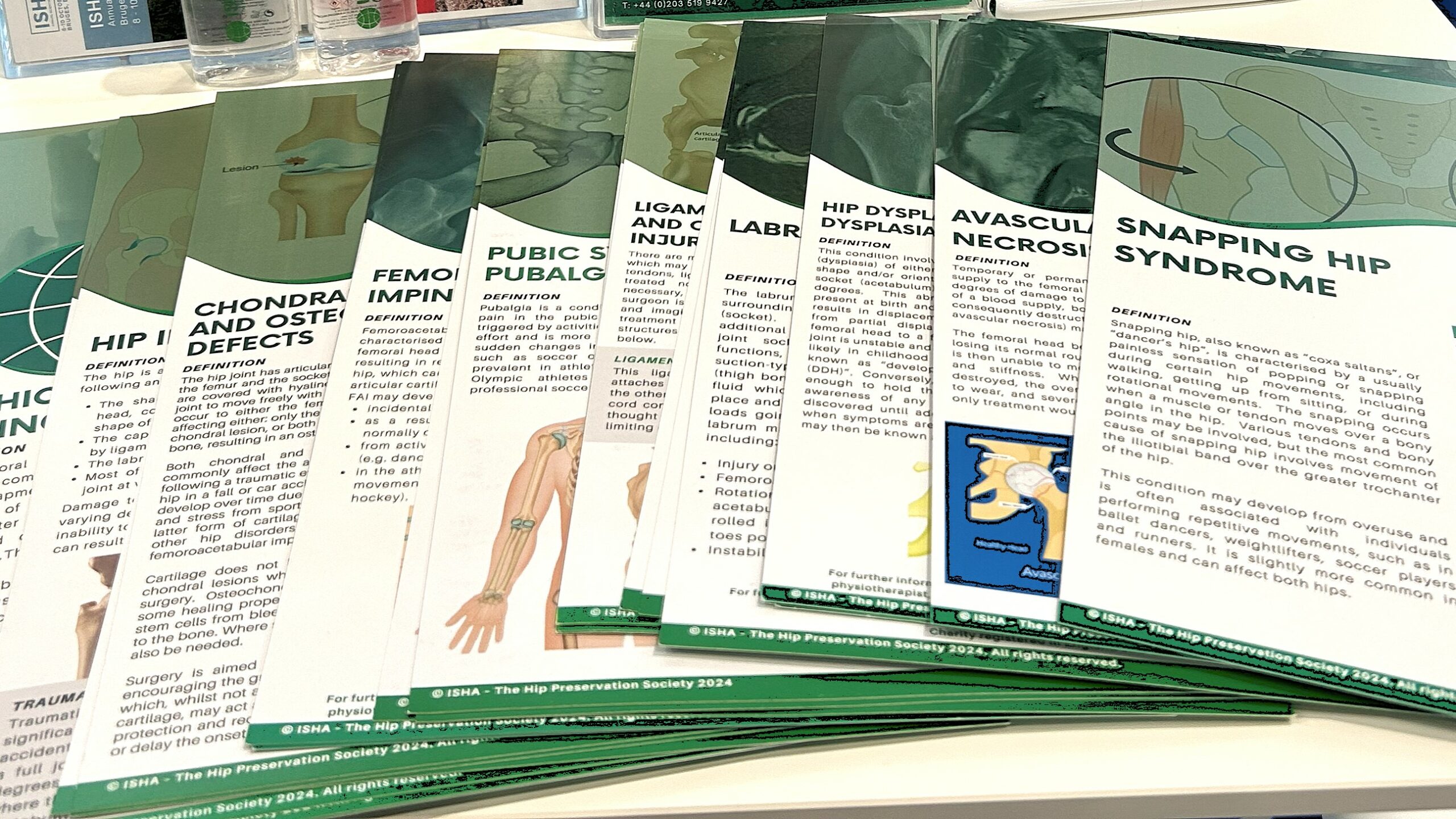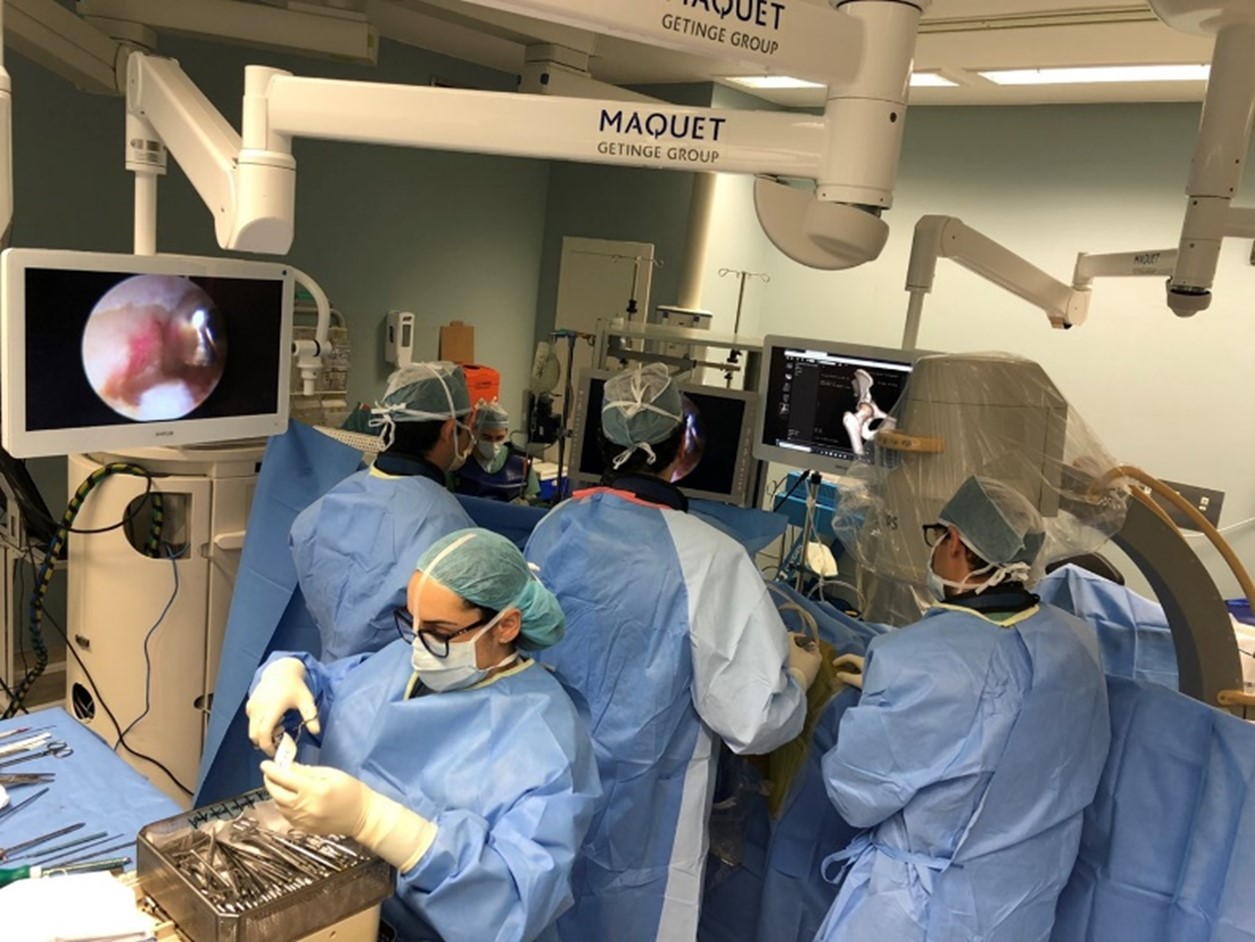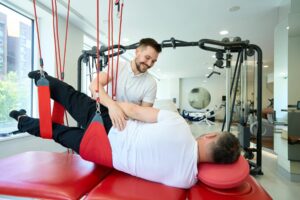Patient Information

Welcome to the Patient Information section of the ISHA – The Hip Preservation Society website.
ISHA aims to provide some of the best resources available for patient information in the field of hip preservation. A wealth of materials and information is constantly under development, so please check back on this page for any new releases.
Hip Preservation
Orthopaedics is the medical specialty focussing on the correction or prevention of deformities, disorders or injuries of the musculoskeletal system affecting bones, tendons, ligaments and muscles – all structures essential for movement and function.
Hip preservation is a sub speciality of orthopaedics concerned with preserving the native hip, aiming to relieve pain, restore function and delay or prevent the onset of osteoarthritis, which could require more extensive treatment such as joint replacement. Hip preservation surgery may be performed using keyhole methods (arthroscopic surgery) or via a larger cut (open surgery).

Hip Arthroscopy
Joint arthroscopies allow a surgeon to see and treat joints and surrounding structures such as bursas, ligaments, tendons and muscles. They are used to treat a range of conditions affecting the knee, hip, ankle, shoulder, wrist and elbow. They may also be performed for diagnostic purposes.
Hip arthroscopies are performed under anaesthesia. On the operating table the patient’s affected leg will be positioned so that the joint and surrounding structures can be easily seen and reached by the surgeon. Using X-rays to accurately locate the hip joint, two or more small cuts are made, and a telescope (arthroscope) containing a light source and camera is inserted. Images taken by the camera are then relayed live throughout the procedure onto a screen.
Surgical instruments for tidying or repairing damaged tissue are inserted via another cut enabling the surgeon to treat the injury or condition. Once treatment is complete the instruments and camera are removed, the cuts are closed, and the patient is moved to the recovery room before returning to their hospital room to recover.
Whilst a hip arthroscopy is performed using small cuts, the procedure may still be considered major surgery, and may take between one and three hours depending on the treatment required.
What conditions does hip preservation aim to treat?
There are many conditions affecting the hip joint and surrounding soft tissues – the most common are listed adjacent. Click on each condition to find out more about signs, symptoms and possible treatments.

- Femoroacetabular impingement (FAI)
- Labral tears
- Lateral hip pain / greater trochanteric pain syndrome (GTPS)
- Instability
- Hip dysplasia / developmental dysplasia of the hip (DDH)
- Pubic symphysis pain
- Snapping hip syndrome
- Avascular necrosis (AVN)
- Cartilage defects
- Ligamentum teres tears and other soft tissue injuries
- Perthes
- Ischiofemoral impingement (IFI)
- Chondromatosis
- Pigmented villonodular synovitis (PVNS)
- Hip joint alignment
- Psoas related injuries and conditions
What health practitioners are involved in hip preservation treatment and education?
Below follows further information about the different health practitioners who may be involved in the care of patients with hip injuries and conditions. These may vary between different countries.

Orthopaedic Surgeon
A hip preservation surgeon will take a detailed history of any signs and symptoms concerning the hip condition or injury, and will perform, with the patient’s consent, a physical examination. It may be necessary to perform tests such as X-ray, MRI, ultrasound or CT scanning, and/or blood tests. Once all the results have been collected the following may be discussed:
- Diagnosis of the injury or disorder
- Treatment options
- Referral to a physiotherapist or sports therapist
- Preventative measures with information and treatment plans to prevent injury or slow the progression of disease

Non-Surgical Treatment
Orthopaedic surgeons treat many conditions without surgery using advice, medication, interventional radiology, exercise and other therapies. For most orthopaedic conditions and injuries there is more than one form of treatment but if there is limited or no improvement following non-surgical treatment surgery may be recommended.
Surgical Treatment
Orthopaedic surgeons perform many different surgical procedures including:
- Hip arthroscopy – surgery that uses special cameras and equipment to look at, diagnose and treat problems around and inside the hip joint via small cuts.
- Open joint preservation surgery – the joint is reached using a larger cut enabling the surgeon to examine and treat any problems by looking directly at the hip.
- Soft tissue repair – the repair of soft tissues, such as torn tendons, ligaments and muscles.
- Internal fixation – metal plates, pins or screws are used to hold together broken bone whilst it is healing.
- Osteotomy – the correction of bone deformities by cutting and repositioning the bone.
- Replacement surgery – removal of damaged joint surfaces and replacing them with artificial replacements e.g. total hip replacement.

Education and Training
An orthopaedic surgeon will be a medical doctor with many years of training in the diagnosis and treatment of injuries and diseases of the musculoskeletal system. Most orthopaedic surgeons specialise further, limiting their practice to either one or two joints and/or focussing on a specific age group such as adult or paediatric orthopaedics. They may further specialise in the treatment of specific conditions such as sports injuries, bone and soft tissue cancers, or trauma. Throughout their career they will continue attending relevant courses, taking further examinations to remain up to date with current treatment methods. Surgeons will often become members of professional societies which share education and scientific research in their chosen area of expertise. A hip surgeon, for example, could join ISHA – The International Hip Preservation Society.
Physical Therapist/Physiotherapist
Patients may self-refer to a physiotherapist, or may be referred by their GP or orthopaedic surgeon, where they will be assessed in terms of mobility, strength and function. A treatment plan will be agreed between the patient and the therapist and may include the following:
- Exercises to improve range of movement, strength, balance and stability
- Activity modification
- Postural advice
- Use of ice
- Acupuncture
- Pilates
- Manual therapy
- Hydrotherapy
- Gait analysis
Education and Training
A physiotherapist will have gained a degree before acquiring a licence to practice. Once qualified, physiotherapists may develop a particular area of interest such as the management of hip disorders. Throughout their career they will attend further courses to enhance their skills and keep up to date with current research and innovations.
Sports Therapist
Sports therapists are professionals who specialise in caring for the health of athletes. Their work within the field of hip preservation may involve the following:
- Treatment and management of injuries to relieve pain
- Rehabilitation following injuries using manual and exercise therapy techniques
- Design and monitoring of rehabilitation programmes appropriate to specific sports and levels
- Coordination of referral to other practitioners
Education and Training
A sports therapist will have completed an approved undergraduate degree or postgraduate degree in sports therapy. It may also be possible to specialise as a sports physiotherapist by completing a degree in physiotherapy and then attending further specialist courses in the management of sporting injuries.

General Practitioner (GP)
A GP, or family physician, may be the first medical practitioner encountered upon experiencing or suspecting a hip condition or injury. During a brief consultation, referral to either an allied professional such as a physiotherapist or sport therapist, or immediate referral to an orthopaedic surgeon may be arranged. Sometimes, imaging and/or blood tests are arranged before any referral to confirm the condition is orthopaedic in nature.
Education and Training
A GP or family physician will be a medical doctor who will have completed several years of formal education recognised by the appropriate, country specific, medical licensing organisation. Once qualified to practice, they will continue attending relevant courses, taking further examinations to remain up to date with current clinical practices.
Radiologist
Imaging plays an important role in the diagnosis of any hip injury or condition and may involve a range of methods, including X-ray, MRI, CT and ultrasound scanning. Interventional radiology which may include arthrograms (specialised type of MRI requiring injection of a contrast agent prior to scanning) and image guided diagnostic local anaesthetic injections may be used to confirm the source of pain and the nature of the tissues involved.
An interventional radiologist may also perform treatments such as therapeutic injections (e.g. corticosteroid, PRP, hyaluronic acid) either into the hip joint or surrounding structures.
Education and Training
A radiologist will be a medical doctor with extensive training in the interpretation of diagnostic imaging to guide the management of injuries and diseases. After gaining a licence to practice, they will continue attending relevant courses, taking further examinations to remain up to date with current clinical practices. Radiologists, like orthopaedic surgeons, develop areas of interest such bone and soft tissue or musculoskeletal conditions.
Nurse
A nurse will have completed either a degree or a degree apprenticeship course and once qualified can choose to specialise in a specific area of medicine, such as orthopaedics. In the UK, some nurses may become known as clinical nurse specialists (CNS) and will work entirely in their chosen field, having completed relevant post-graduate courses.

Physician Associate
A physician associate may work alongside GPs or hip preservation surgeons, assisting in the management of hip conditions or injury.
Education and Training
To qualify as a physician associate, a two year postgraduate diploma or Masters degree is required. This course combines theoretical study with clinical experience gained in general, community and emergency medicine. This would generally be undertaken after an initial undergraduate degree in a health or life sciences subject such as biochemistry, medical science, healthcare science or nursing. Physician associates are not medical doctors or surgeons.
Theatre Team
Any hip preservation surgery will take place in an operating theatre. The procedure will be led by a hip preservation orthopaedic surgeon together with an anaesthetist and varying numbers of the following health professionals:
- Physician associate
- Assisting surgeons and/or anaesthetists
- Theatre nurses
- Operating department practitioners
- Porters
- Administrative staff
Anaesthetist
Anaesthetists will administer the required anaesthetic for a surgical procedure to take place. They will also manage pain relief before, during and after surgery. For most hip preservation procedures, either general or spinal anaesthesia will be used and the choice will depend on the patient’s medical history, surgeon preference and the procedure in question.
Education and Training
Anaesthetists are medical doctors with extensive training and the skills to provide a range of treatments, including anaesthetics for surgical and medical procedures. They can also be involved in pain management, resuscitation of acutely unwell patients, and lead chronic pain services and intensive care units. They will have completed several years of formal education and once qualified to practice will continue attending continuing professional development courses, taking further examinations to remain up to date with current clinical practices.
Find a Surgeon or Physiotherapist
If you or a family member believe you may suffer from a hip injury or have been recommended for surgery of the hip, please use the “Find a Surgeon” tab to identify a local ISHA member to assist you.
If you are looking for rehabilitation and/or hip preservation support, our list of physiotherapist members who have a specialist interest in hip injury will be able to help. Please visit the “Find a Physiotherapist” tab.
Please share our site with those interested in finding the most up-to-date surgeons and medical professionals in the area of hip preserving (non-replacement) surgery in the world.